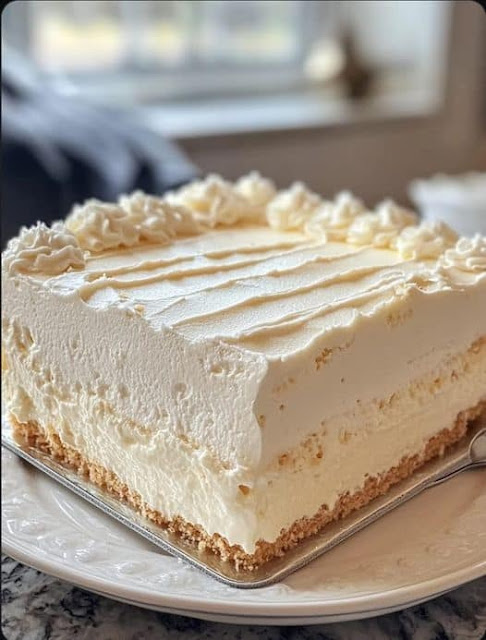
Step-by-Step Instructions for Making Traditional Cream Cheese Cake
Step 1: Prepare the Crust
- Preheat the Oven: Preheat your oven to 325°F (163°C). Grease a 9-inch springform pan lightly with butter or non-stick spray to prevent sticking.
- Make the Crust Mixture: In a medium-sized bowl, mix the graham cracker crumbs and sugar until combined. Pour in the melted butter and stir until the mixture resembles wet sand.
- Press the Crust into the Pan: Pour the graham cracker mixture into the bottom of the prepared springform pan. Using a flat-bottomed glass or the back of a spoon, press the crumbs firmly into the bottom to form an even layer.
- Bake the Crust: Place the pan in the oven and bake for 10 minutes to set the crust. Remove and let it cool while you prepare the filling.
Step 2: Make the Cream Cheese Filling
- Beat the Cream Cheese: In a large mixing bowl, beat the softened cream cheese with an electric mixer on medium speed until smooth and creamy, about 2–3 minutes. Avoid over-mixing, as this can lead to cracks in the cake later.
- Add the Sugar: Gradually add the granulated sugar and continue mixing until well combined and smooth.
- Incorporate the Sour Cream and Vanilla: Add the sour cream and vanilla extract to the cream cheese mixture and mix on low speed until combined. The sour cream gives the cheesecake its traditional creamy texture and slight tang.
- Add the Eggs: Add the eggs one at a time, mixing on low speed just until each egg is incorporated before adding the next. This helps to prevent too much air from being added to the batter, which can cause cracks during baking.
Step 3: Assemble and Bake the Cheesecake
- Pour the Filling into the Crust: Pour the cream cheese filling into the prepared crust. Use a spatula to smooth the top so it’s even.
- Create a Water Bath: Wrap the bottom of the springform pan in a double layer of aluminum foil to prevent water from seeping in. Place the pan in a large roasting pan, then pour hot water into the roasting pan until it reaches about halfway up the sides of the springform pan. The water bath helps to bake the cheesecake gently and evenly, reducing the chances of cracking.
- Bake the Cheesecake: Carefully place the roasting pan in the oven. Bake at 325°F (163°C) for 75–90 minutes. The cheesecake is done when the edges are set but the center is still slightly jiggly.
- Turn Off the Oven: Turn off the oven, crack the door slightly, and let the cheesecake cool in the oven for 1 hour. This gradual cooling process prevents rapid temperature changes, which can also cause cracks.
Step 4: Chill the Cheesecake
- Remove and Cool Completely: After 1 hour in the oven, remove the cheesecake from the water bath and let it cool completely at room temperature.
- Chill in the Refrigerator: Cover the cheesecake with plastic wrap and refrigerate for at least 4 hours or overnight. This chilling period helps the cheesecake set and enhances its flavor.
Serving Suggestions
After chilling, your traditional cream cheese cake is ready to be enjoyed! Here are some ways to garnish and serve it:
- Fresh Berries: Top the cheesecake with fresh strawberries, blueberries, or raspberries for a burst of color and flavor.
- Whipped Cream: Add a dollop of whipped cream on each slice for a classic touch.
- Chocolate Sauce: Drizzle a bit of chocolate or caramel sauce over the top for a decadent finish.
- Shaved Chocolate or Nut Toppings: Sprinkle chocolate shavings, chopped nuts, or even a light dusting of powdered sugar for a final flourish.
Tips for Perfect Cheesecake
- Use Room Temperature Ingredients: Ensure that your cream cheese, eggs, and sour cream are at room temperature before you start. This helps everything blend together smoothly and prevents lumps.
- Avoid Over-Mixing: Over-mixing introduces too much air into the batter, which can cause the cheesecake to rise, fall, and crack.
- Bake in a Water Bath: A water bath ensures even cooking and prevents the edges from drying out before the center is done.
- Cool Gradually: Allowing the cheesecake to cool slowly in the oven and then at room temperature helps prevent cracks.
- Refrigerate for the Best Flavor: Cheesecake tastes best after it has chilled for several hours or overnight, so try to plan ahead for the best results.








No Responses Yet